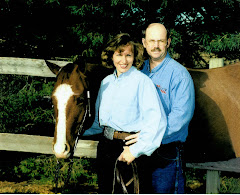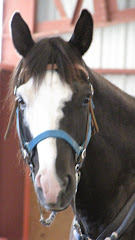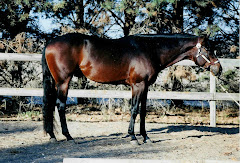
Day 2. Carol teaches so relaxed and so effortlessly! I am loving her as an instructor!
12 riders were split into 5 groups, with each group riding for an hour. I was lucky enough to pull the last group! 3:45 - 4:45 in 90 degrees! Luckily, the indoor arena was a spacious 70 x 140’, with an additional 20’ on the end for seating. Sliding doors acted like large windows on the sides, allowing for a cross breeze. It was actually very pleasant in the arena!
Most of the riders were not new to riding, but did not have a lot of Centered Riding experience either. Some were intimidated by their horse’s fast gait. Some were trying to find their balance at the trot and lope. Some were on sensitive horses who felt their riders tension.
The first group was taught where to sit and to find their balanced seat by tipping their pelvis to find their center. To relax the horse, the riders were told to yawn, which in turn, made their horse “yawn” and slow down. The group worked on “S” turns, which helps to relax the horse, which in turn allows the horse to breathe. A horse can’t turn easily if he is stiff. The riders were taught to turn from their center by using their belly button as a guide.
To send the horse off into the trot, the riders took a deep breath and blew out loudly, pushing the air out with a puff, adding their legs when necessary to get the desired gait. By focusing on the center, and spinning a ball in your center, you make the horse aware that you are asking for a faster gait. To slow down, the rider sat, breathed out and down to ask for the stop. With a soft eye, the riders guided their horses through cones, turning with their center. A soft eye allows the rider to be more aware of what is going on around him.
The “Bubble and Spring” is the place where the foot goes on the stirrup. With the foot properly placed, you allow the horse to be a freer mover. You can absorb motion through the ankle, knee, and hip. Breathing relaxes the horse and rider. Soft eyes keep the rider from getting stiff. All of this works together to keep the horse from getting too stiff.
The 2nd group worked on thinking tall and relax the rider’s shoulders. They worked on contact on the reins with their tricep muscles, keeping a bend in the elbow and keeping the elbow elastic and soft. Stirrups were shorten after Carol rotated the hip joint and lengthened the leg. The body was to be a “clothesline”, stretching outwards with the shoulder and allowing the body to move freer.
When a horse has a big trot, try bouncing on the down of the trot. Ride the horse with the outside of the leg. This frees up the horse to move and releases the rider’s thigh. With soft eyes, walk in a “bubble” with clear intent of where you are going. This causes the horse to remain in focus with the rider. The riders practiced going through 2 cones set on a diagonal in the corner, first going between the cones, then riding on the outside of the cones. With this focus, the riders worked on their intent of where they wanted the horses to go.
These riders learned to remain relax to stay centered. They were to stay in the middle of the horse’s ride, with their chest up. The bubble exercise helped to channel the horse’s energy.
The 3rd group worked on allowing movement in the seat. They were to feel the front to back and side to side movement. As they felt their seat bones, they were to feel first one side then the other side. To become more aware of their seat bones, they thought of peddling a bike backwards. The faster you peddle, the faster the movement of the horse. The slower you peddle, the slower the horse’s movement. As the body relaxes, the body and hip moves front to back. They worked on circling cones, keeping their eyes up and looking around the circle. The riders worked on having less tension in the legs, by feeling the feet on the bottom of the boot. As they halted, they were to breath into their center, breathing down.
The riders learned to soften their own back to help lengthen the horse’s stride. The riders worked on relaxing their whole leg, from their hip, down their leg, to their foot.
Group 4 worked on the same techniques as the above groups. They worked on cone exercises, with soft eyes to weave the cones. They grew more confident as they worked their horses through the cones and circled the cones, and as they forget about their tension.
I was in the last group with 2 other riders. We each wanted to make sure that we sat as centered as possible. Carol made subtle adjustments, some only ¼”, to how we sat, to help lengthen our body and legs. She worked on freeing our hips and relaxing our legs. With me, she worked on my hip joint to allow it to open more, allowing the upper leg to sit higher, yet maintaining the knee bend. As we first walked, she wanted us to feel ouir knees. Could we feel them move up and down as the horse walked. We trotted, with a hand on our knee to feel the upward and downward movement of the knee.
We rode at the 2 point, finding our deep center. As we lowered our body into the saddle as we sat, barely touching the saddle, we concentrated on what our knees were doing. We worked on an exercise: posting, 2-pointing, sitting the trot. As we worked on the lope, using our center to stay grounded, we found the place were we were relaxed.
Pictures to come soon, I promise,. 11:30 and I am tired. Early day tomorrow. I ride at 7! Night!
May 21, 2009
Day 3
The day was forecasted to be hot. Our group volunteered to go first. That was great. I would rather ride in the cool 60’s morning than a 90 degree afternoon, even if I was riding an hour earlier than the day was scheduled to start. But no one told us that we were going to have thunder and a storm in the area during the night, awakening me at 3 am! I never sleep good when I am away - too excited for the following day, I guess. So I am wide awake at 10 pm, and 11 pm, and finally went to bed before midnight. Awaken with the thunder, maybe some hail, at 3 am, so I went outside - and no one else was outside - and shut trailer windows. Then back to bed, shutting trailer windows. Listening to the thunder and wondering if we were getting the storm. I actually went back to sleep without knowing if it was raining, and that darn alarm woke me at 6 am out of a deep sleep! Wouldn’t you know it!
Our ride time was great! Have I said how much I am loving Carol Wilson as an instructor! She is so positive, supportive, and with a unique humor! She has many years, no decades, of balanced riding techniques and she teaches well with an educated eye! I just love her coaching!!!
We started the morning ride session with some stretches, since I and another rider was stiff through the pectoral (chest) muscle area from yesterday’s ride session. With the up and outward stretch of the muscles while we rode, it was enough to stretch them to tightness today. I felt some relieve from the tightness after the stretches!
I was in the arena about 10 minutes early, and long trotted Finny down. As we started the session, Finny was more relaxed than the previous day. Poles were laid in a pattern in the arena,. We were told to ride in our “bubble”, using the whole arena to ride with “soft eyes” and “intent”. We could walk or trot, and go around or over the poles.
We were to ride “centered” and turn with our “center”. We could use a little inside rein when necessary to help the horse to look where he was going. When you ride with soft eyes, AND breathe, the horse is so much more relaxed. Remember to spin the ball in the center to have your horse move out freely. Remember to back peddle to slow your horse down and stop.
We fine tuned today! The group, per the instructor, told us that we were sponges and soaked up the information. Maybe a little alpha! Lol
We trotted one at a time, crossed the arena on the diagonal, and loped off in the opposite direction. The transitions were smoother when the rider used soft eyes, raised up and widen through the chest, and looked around the corners.
My group was well matched. We all worked on sitting the long trot and posting the trot, using our center. We wanted to have smooth lope departures, using our center to lope. This is a concept that I will work on, as I always have “pushed” the horse into a lope with my outside leg, asking for a forehand step before the lope departure.
We practiced holding the reins correctly, with the hands turned up, the pinky finger on the outside of the rein, and the thumb on TOP of the rein. With on a slight tightening of the rein, you should be able to turn the horse. Ask to see the horse’s eye first, before making the turn.
Remember, Centered Riding Simplifies Riding!!! Don’t get “hard eyes” “inward”. Don’t concentrate so much that you forget what you are working on.
Ride with SOFT EYES. BREATHE. Find your BUILDING BLOCKS to set up your CENTER. GROU ND with your feet, with even pressure on your stirrup. Ride with CLEAR INTENT.
I’m excited to change my focus and am looking forward to this journey!!! Come along on this fascinating ride with me!!! Remember, Centered Riding is a Process! Relax and take your time getting there!



 For the last month and a half, I have been conditioning for the start of CTR, Competitive Trail Riding. Lots of field riding and trotting to get the extra weight off of my horse, Finny. Hosting a Centered Riding Clinic, with some CTR friends, to work on correct body positioning. Even conditioning myself with lots of posting and 2-pointing at the trot. The first ride was this past weekend at Cherryvale, Kansas. A beautiful place to ride. Trees and forest. Just like I grew up with. Throughout the ride, we rode next to the lake or saw the lake through the trees.
For the last month and a half, I have been conditioning for the start of CTR, Competitive Trail Riding. Lots of field riding and trotting to get the extra weight off of my horse, Finny. Hosting a Centered Riding Clinic, with some CTR friends, to work on correct body positioning. Even conditioning myself with lots of posting and 2-pointing at the trot. The first ride was this past weekend at Cherryvale, Kansas. A beautiful place to ride. Trees and forest. Just like I grew up with. Throughout the ride, we rode next to the lake or saw the lake through the trees.











